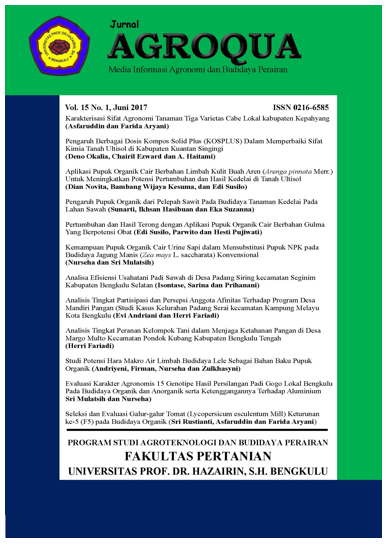PENGARUH KOMPOSISI PAKAN TAMBAHAN LIMBAH SAYURAN TERHADAP PERTUMBUHAN IKAN NILA (Oreochromis niloticus)
DOI:
https://doi.org/10.32663/ja.v19i1.1787Keywords:
Tilapia (Oreochromis niloticus),, waste, water spinach, green cabbageAbstract
The purpose of this study was to determine the effect of the composition of feed from vegetable waste on the growth of tilapia (Oreochromis niloticus). This research was conducted for 35 days, starting from June to July 2020, located in Kelurahan Betungan RT. 50 Districts Selebar Bengkulu City. The container used is a tarpaulin pool with a length of 1 m, a width of 0.5 m, and a height of 0.5 m totaling 16 units. The size of the fish used in this study was 7-8 cm. The design used was a completely randomized design (CRD) consisting of 4 treatments and 4 replications in order to obtain 16 treatment units in which treatment P1 = 5% water spinach, P2 = 5% green cabbage, P3 = 2% water spinach + 3% green cabbage and P4. = 3% Kale + 2% green cabbage. To determine the effect of the additional feed composition of vegetable waste on the growth of tilapia (Oreochromis niloticus), an analysis of variance was carried out at the 5% and 1% levels. Meanwhile, to see the best additional feed, a further 5% BNT test was carried out. The parameters observed during the study were fish growth which included absolute weight, absolute length, feed conversion, feed efficiency, feed conversion, and survival. The results showed that the additional feed composition of kale and green cabbage vegetable waste had a very significant effect on the growth of tilapia (Oreochromis niloticus), conversion, and feed efficiency, but had no effect on survival. The growth in absolute weight and length, feed conversion, and best feed efficiency was found in kale 5% and had a survival rate of 91%.
References
Downloads
Published
Issue
Section
License
Authors who publish with this journal agree to the following terms:
- Authors grant the journal right of first publication with the work simultaneously licensed under a Creative Commons Attribution 4.0 Internasional (CC BY 4.0) Licence that allows others to use and share the work with an acknowledgment of the work's authorship and initial publication in this journal.
- The author(s) still hold the copyright of his/her/their work and retain publishing rights without restrictions such as (but not limited to) patent right, lecture, book and reproduce the article for own purposes.
















